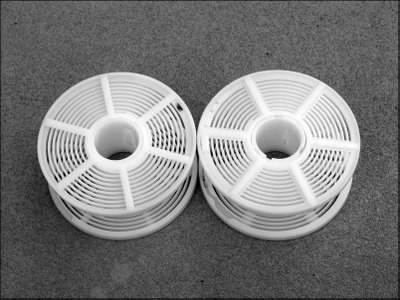Don’t let anybody tell you that loading a stainless steel reel with film is like riding a bicycle. In 1968, I could do both. In 2006, I can barely ride a bike, and you can forget having me load a stainless steel reel in the dark. My first 35mm and 120 negatives were developed in
a Kodacraft tank with film aprons. If you're under the age of 40, you don’t remember aprons. They were film-length pieces of clear plastic with corrugated edges. You would tuck the leading edge of the film under a loop at one end of the apron, and then roll the two together into a coil. The corrugated edges of the apron kept it from directly touching the film except at the edges. Those corrugated edges left a narrow gap between the film and apron, allowing developer and fix to reach the film. The rolled up apron and film went into the lightproof Kodacraft tank. Unfortunately, the Kodacraft tank had an open orifice on the lid with no cap. Agitation consisted of moving the tank on a flat surface in a figure-8 motion. Primitive to be sure, but very easy to use. But I wanted to invert the tank during agitation, so I went to the other choice, stainless steel reels and tanks. Loading a stainless steel reel took a lot of practice, and I spent considerable time watching
Gunsmoke reruns at 11:00 P.M. while loading and reloading a 35mm stainless steel reel with a roll of old film.
After a hiatus from photography of about 18 years, I washed my old stainless steel reels and gave them another shot. Forget it. All thumbs. Crinkled film. Too aggravating. So I bought some Paterson reels. Very usable, and much easier to load, at least in 35mm. But there was still a bit of a challenge getting the film into the narrow tracks of the reel. With most plastic reels, loading involves shoving the film lengthwise into a spiral track. Unless the conditions were perfect, I could spend 20 minutes in a dark, non-air conditioned bathroom trying to get the film into the small insertion point on the reel. It became much more difficult when I started buying some rather tightly-curled Europeans films. Those were a challenge in 35mm and completely ridiculous in 120 format.
A perusal of the B&H Photo site yielded Samigon plastic reels. According to the description, they are fool proof. These reels look very much like Paterson reels, and they fit perfectly in Paterson tanks and Samigon plastic tanks.
 Which is the Paterson and which is the Samigon?
Which is the Paterson and which is the Samigon?
Like Paterson reels, they have a larger diameter than stainless steel reels and will not fit in stainless steel tanks. They also load just like Paterson reels but have a major improvement. At the base of the entry spot on the reel, they have a very large deck that you can place the film end on, guiding it into the narrow entry slot with your index finger. Paterson reels have two short nibs to help you find the entry slot. Samigon gives you a contiguous platform.
 The Samigon reel on the right has a contiguous entry ramp to get the film started on the reel.
The Samigon reel on the right has a contiguous entry ramp to get the film started on the reel.The fool proof Samigon reels have no instructions, and it took a few minutes for this fool to figure out that the reel has to be taken apart to remove the developed film. Like the Paterson reels, a clockwise turn of the right side unlocks the two sides and allows you to pull them apart. This is also a major plus. Instead of pulling the wet (and fragile) film out of the reel lengthwise, it will easily plop out into the Photo-Flo bath. Fewer chances to scratch the emulsion.
Speaking of Photo-Flo, it is best not to immerse plastic reels into Photo-Flo solution. Residue tends to accumulate on the plastic, causing binding when trying to slide the film in the slot. Also, since you will be pushing about five feet of film into a spiral track, it is vital that the leading edge of the film not have any rough edges or spikes. I generally make a rounded leading edge with scissors before trying to load the film. Also, both Paterson and Samigon reels use a pair of ball bearings to "grab" the film while ratcheting it into the reel (visible in the second photo above). I have gotten several Paterson reels with a ball bearing that didn't jiggle freely in its slot. If both ball bearings don't jiggle freely in their slots, you cannot feed the film into the reel.



<< Home